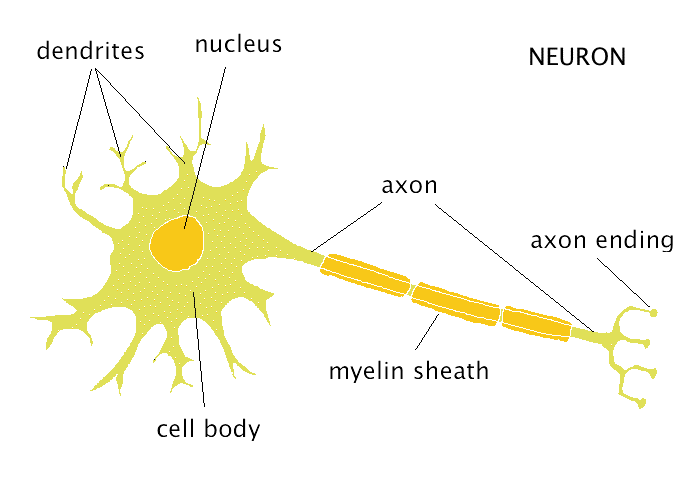Neurons - Introduction to Psychobiology (Part 1)
Structure and Functions of Cells of the Nervous System
For more information about biopsychology, please check out "Physiology of Behavior" by Neil Carson. We'll start the series by talking about the cells of the nervous system, specifically neurons. These cells are located within the two structures that make up the central nervous system (CNS), the spinal cord and the brain, and they process information (1). These cells can be categorized by function and structure. In the former, neurons are divided into three categories depending on whether they process somatosensory information, motor information, or if they aid in the communication from a sensory to a motor neuron (4). For example, sensory neurons process experiences such as a touching sensation on the skin. On the other hand, motor neurons send information from the CNS to body parts such as muscles in order to create movement. Fun Fact: It is estimated that there are around 100 billion neurons in the brain (4). In addition, it is important to note that the outside of the brain and spinal cord is known as the peripheral nervous system (PNS). There are cells that are unique to the CNS and the PNS, but these areas will be covered later.
We'll start the series by talking about the cells of the nervous system, specifically neurons. These cells are located within the two structures that make up the central nervous system (CNS), the spinal cord and the brain, and they process information (1). These cells can be categorized by function and structure. In the former, neurons are divided into three categories depending on whether they process somatosensory information, motor information, or if they aid in the communication from a sensory to a motor neuron (4). For example, sensory neurons process experiences such as a touching sensation on the skin. On the other hand, motor neurons send information from the CNS to body parts such as muscles in order to create movement. Fun Fact: It is estimated that there are around 100 billion neurons in the brain (4). In addition, it is important to note that the outside of the brain and spinal cord is known as the peripheral nervous system (PNS). There are cells that are unique to the CNS and the PNS, but these areas will be covered later. Even though neurons can have different structures, the majority of them are composed of similar elements. These include the body of the cell known as the soma, which contains organelles that perform vital functions. Neurons work like cell phones in the sense that one end of the cell receives information while the other sends it. In this case, the dendrites, which look like tree branches receive information from other neurons. The way neurons communicate is through action potentials, which is basically electricity sent trough the axon. Once it reaches the end, neurotransmitters are released from the terminal buttons so they can reach receptors located in the dendrites of another cell. Action potentials are a complex process that will be described in depth later on, for now it is sufficient to be aware of the parts involved in it.
Types of neurons
In terms of structure, neurons can be categorized as multipolar, unipolar, or bipolar. The former has a larger population in the brain(3). This is composed of one axon and many dendrites attached to its soma while the latter has an axon on one side of the cell and dendrites on the other.


A unipolar cell has only one stalk that divides into the axon and the dendrites. Bipolar cells are usually found in sensory systems such as vision. Unipolar neurons usually work with somatosensory functions such as feelings of pain and temperature (5). Both of them receive information from the external world and send it into the CNS.
As stated before, neurons communicate through the release of neurotransmitters. They are released from the terminal buttons after an action potential into a structure known as the synapse. This is composed of three parts: the presynaptic neuron, which is the neuron that releases the neurotransmitters, the postsynaptic neuron, which is the neuron that contains the receptors that are going to attract the neurotransmitters, and the synaptic cleft, which is the space between the presynaptic and postsynaptic neurons. Once the neurotransmitter binds to the receptor, it either inhibits the postsynaptic cell or it excites it and in turn that neuron either excites or inhibits other neurons downstream and so on. This is how neurons communicate.
References
http://www.britannica.com/science/sensory-neuron
http://vanat.cvm.umn.edu/neurLab1/neuron.html
Physiology of Behavior by Neil Carson
http://neuroscience.uth.tmc.edu/s2/chapter02.html



Comments
Post a Comment